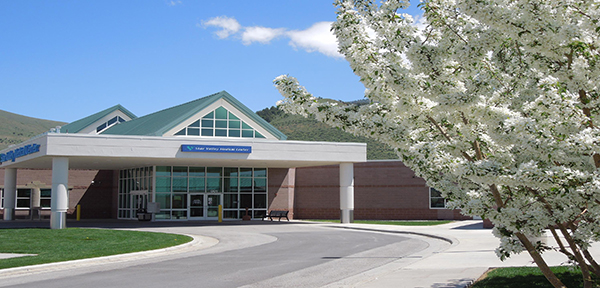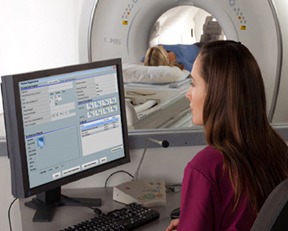
Among the many requirements a hospital must meet to achieve and maintain the designation of Critical Access Hospital (CAH), the hospital must be fairly remote and furnish 24-hour emergency care services seven days a week, using either on-site or on-call staff.
As a Critical Access Hospital (CAH), Star Valley Medical Center in Afton, Wyoming, is located in a rural area surrounded by mountains to both east and west. The progressive, 24-bed community hospital serves a small number of farming communities with high-quality care and state-of-the-art medical imaging. This combination keeps patients close to home and loved ones even when their care requirements get more complex.
One recent decision made in support of the quality of care at Star Valley was the decision to move from using a mobile MR unit to installing a fixed MR installed at the hospital.

“Star Valley performs beyond just the minimum requirements,” says Terry Lemon, radiology director at Star Valley Medical Center. “Our intention is to have the equipment and resources to offer specialized care and perform complex procedures very well, so that our patients are getting the same level of care as they would get at a large hospital.”
Demand is high. Lemons says there are days where six knee replacements are performed. “We have a vibrant orthopedic department, two general surgeons, an obstetrician, and a number of general family practitioners. We also have a number of visiting specialists serving our community of 1,800, including a neurosurgeon, cardiologist, dermatologist and an ear nose and throat specialist.”
Until earlier this year, Star Valley offered MR via contracted mobile services. A truck was scheduled to arrive at the hospital based on the number of exams ordered. Initially, the mobile unit met their needs well, but soon, they were imaging at full capacity.
“When we began using the mobile MR, we were scheduled for two, half days each week,” Lemon recalls. “That quickly changed to three, half days, then four. With the schedule being booked out completely, there was never an option to add a patient who needed an urgent exam. At times, patients were waiting a couple of weeks for an appointment. Accessibility was becoming a major issue.”
Even when there was a possibility to add an exam, sometimes the truck couldn’t wait. The truck needed to stick to the schedule to meet the time commitments at the next facility. The nearest hospitals to Star Valley include a small hospital about 50 miles away in Idaho that used the same mobile MR unit, as well as a large facility in Jackson Hole, Wyoming, that had a fixed, 70cm MRI. Lemon realized patients in his community were opting to drive the 70 miles to Jackson Hole to get MR exams more quickly.
He knew the exodus of patients to Jackson Hole wasn’t only to do with the delays, but also due to lack of patient satisfaction. Star Valley patients had a great deal of apprehension using the mobile unit, notably because it was small and dark “with an even smaller, darker, enclosed tunnel. It was very claustrophobic,” he says. “We were losing patients due to anxiety, in addition to limited access.”
There also were times, due to Star Valley’s mountainous location and treacherous weather conditions, that the mobile MR truck couldn’t reach the hospital at all. The combination of lack of access, patient satisfaction, and dependability pushed the team to make the move to install a fixed MR unit.
Economics of course was first, with Star Valley conducting a comprehensive feasibility study to determine whether it would be cost effective to install an MR unit on site. “It became pretty obvious from a cost perspective that we could afford a fixed unit,” Lemon recalls. “We would be able to grow the patient base and increase utilization. It was a matter of vendor evaluation after that. We looked to address patient [and physician] satisfaction as the driver of that evaluation,” Lemon explains. “We are a small community. We care what their expectations of us are.”
So Star Valley surveyed both the patient and the physician communities to understand their expectations of MRI services. The results were very clear. Patients wanted an MR system with a large opening, a short tunnel and they wanted it to be “loaded” with high-tech features, Lemon says.
“The perception is that the big city must do it better, so if patients were going to have a say in the kind of system installed at Star Valley, they wanted to make sure it had all the newest and latest technology. They wanted the same as what they’d expect to find in a larger hospital,” Lemon explains. Physician polling results echoed the same expectations as patients.
To meet the imaging needs at the hospital, Star Valley chose to purchase a closed system and investigated the available options. The team met with the major MR vendors and compared system specifications.
“From the very beginning, it was pretty clear that the Fujifilm Oval was the best option for us,” Lemon says. “The Oval had the widest bore of all the closed systems we reviewed, and it also had the shortest tunnel. It also offered a lot of comfort features that would help to alleviate patient anxieties about the exam.”
Lemon and his team were not shy about kicking the tires, either. They tested the system themselves—laying inside the bore and moving in and out to feel what patients would feel.
The Fujifilm team arrived in December 2013 to install the system. The process took about 10 days to get the Oval fully installed and calibrated. Lemon was extremely impressed with Fujifilm’s application team that spent two solid weeks with his team training them on the new system. After the system was up and running, the vendor team was back for another week to answer questions that came up and continue training. They’ll be back in June for another round of training.
“Fujifilm really wants us to get the most out of our system,” Lemon says. “They have a great training process, and it’s even more impressive that it’s not a profit center. It’s a very refreshing philosophy—they’re willing to stand behind their technology with outstanding service. They worked with our CT techs to learn MRI.” And the vendor continues to watch and guide from afar with remote access, assisting Lemon and his team whenever questions arise.
Based on prior utilization and projections, Lemon planned for a 12 percent increase in utilization in 2014, with a 2 percent increase each year thereafter. The break-even analysis was determined from that projection. Lemon says scanning and utilization are both very going well. “Staggering!” is how Lemon explains it. “There was a dramatic and immediate effect.”
For the past decade, Star Valley has averaged about 32 MRI scans per month. This January, that number was more than doubled with 77 scans on the new system. The next month proved that number was no anomaly. The previous average for February was 39. This year, the facility logged 96 scans.
While Star Valley hasn’t done a formal patient satisfaction survey yet, Lemon knows that word of mouth referrals are one reason for the uptick in utilization. Patients have been very impressed with the new system; everything from its wide bore and short tunnel to its comfort features.
Lemon’s team spent a lot of time making the entire space comforting for the patient. “You can just see the anxiety melt away when the patient enters the room,” he says.
In fact, Lemon recalls one patient who heard about the new system at Star Valley. A veteran and POW of the Korean War, he had suffered three years as a prisoner in a small, confined space. With a medical condition dictating the need for an annual MR exam, he required conscious sedation to overcome severe claustrophobia. He made an appointment to look at the new system at Star Valley. The team even let him take it for a “test drive” to assess his comfort level laying in the bore.
“The patient felt at ease in the exam room and in the tunnel as well,” Lemon says. “After he inspected the room and tried out the tunnel, he wanted to complete his exam then and there. So we called up to Jackson Hole and got the order from his physician. He completed the exam with no sedation and left the building with report in hand. While we can’t ‘measure’ a story like this, we can see we’re clearly impacting patient satisfaction.”